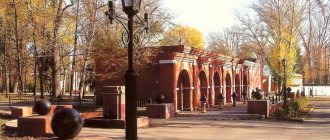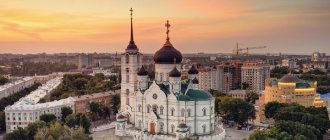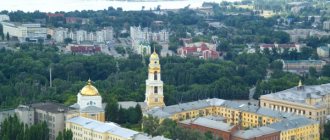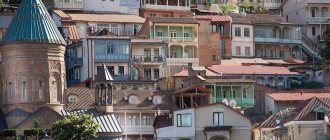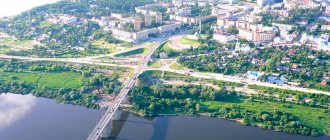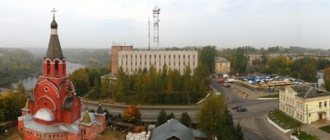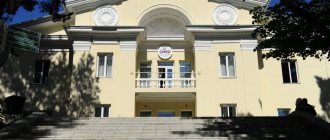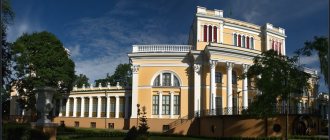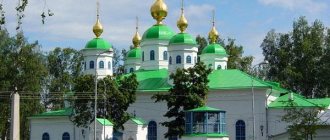Useful
See what “Mozdok” is in other dictionaries:
MOZDOK is a city in the Russian Federation, Northern. Ossetia, on the river. Terek. Railroad station. 39.3 thousand inhabitants (1992). Curtain factory; food and other industries. Near Mozdok, the Terek Kumsky Canal originates from Terek. Founded in 1763 ... Big Encyclopedic Dictionary
MOZDOK - MOZDOK, a city in North Ossetia, on the river. Terek. Railway station. 39.2 thousand inhabitants (1998). Curtain factory; food and other industries. Near Mozdok, the Terek Kumsky Canal originates from Terek. Founded in 1763. Source: Encyclopedia Fatherland ... Russian history
mozdok - noun, number of synonyms: 1 • city (2765) ASIS Dictionary of Synonyms. V.N. Trishin. 2013 ... Dictionary of synonyms
Mozdok is a city in Russia, North Ossetia, on the river. Terek. Railroad station. 39.2 thousand inhabitants (1998). Curtain factory; food and other industries. Near Mozdok, the Terek Kumsky Canal originates from Terek. Founded in 1763. * * * MOZDOK MOZDOK, ... ... Encyclopedic Dictionary
Mozdok - MOZDÓK, city, regional center in the North. Osset. ACCcompare on the river. Terek. Railway station Local industry. In 1941, 12 industrial units operated in Moscow. prtyy. In the beginning. During the war, 5 hospitals were established in Moscow, returning thousands of soldiers to duty. Approximately ... Great Patriotic War 1941-1945: encyclopedia arrived in the city
Mozdok is a regional center in North Ossetia, 92 km north of Vladikavkaz. Located on the southern outskirts of the Tersko-Kuma lowland, on the high left bank of the river. Terek. Railway station on the Cool Gudermes line. Highway junction.... ... Cities of Russia
Mozdok is a city, the center of the Mozdok region of the North Ossetian Autonomous Soviet Socialist Republic. Located on the left bank of the river. Terek. Railway station on the Cool Gudermes line, 91 km north of the city of Ordzhonikidze. 32 thousand inhabitants (1970). Founded in 1763 in the Mazdogu tract... ... Great Soviet Encyclopedia
Mozdok is the first provincial town in the Terek region, on the left bank of the river. Terek. In 1762, the owner of Lesser Kabarda, Kurgoko Kanchokin, receiving St. baptism and having received the rank of lieutenant colonel, he volunteered with part of his subordinates (up to 40 days) to found a Russian settlement in the forest ... Encyclopedic Dictionary F.A. Brockhaus and I.A. Ephron
Source
History of the city of Mozdok
In 1759, the city of Mozdok was not even a settlement, but was a Cossack team of 100 people under the leadership of Andrei Ivanov. Only in 1763 was the fortress built, and in 1765 the city of Mozdok was formed. At that time, the people of Mozdok already included not only Ossetians and Kabardians, as was the case six years ago, but also Armenians, Greeks, Georgians and Circassians.
In 1770, a local resettlement of families took place in the amount of 517 families. At the same time, the Mozdok Cossack Regiment of the Terek Army was created. Their number included the well-known Pugachev Emelyan, who at the same time was immediately appointed military chieftain. However, after a short period of time, Pugachev was detained and placed in custody in prison, where he was kept from 1771 to 1772 in the Mozdok prison. Immediately after, the chieftain managed to escape.
By 1804, almost one and a half thousand Armenians and about a thousand Georgians lived in the city. 1823 becomes the year of construction of the first oil refinery in Russia on the territory of Mozdok. Before the start of the Great Patriotic War, Mozdok underwent more than one change. For example, back in the 18th and early 19th centuries, the city where Mozdok is located was the economic center of the region.
This continued until the construction of a new railway began in 1870. Along with the loss of this status, Mozdok also lost its status as a city. Therefore, until 1925, Mozdok had the status of a settlement. Before the start of the Great Patriotic War in February 1941, the city was transferred to North Ossetia and left the Stavropol Territory. During the war itself, the city was occupied by German troops.
Map
| Mozdok: maps |
Mozdok: photo from space (Google Maps) Mozdok: photo from space (Microsoft Virtual Earth)
| Mozdok. Nearest cities. Distances in km. on the map (in brackets along roads) + direction. Using the hyperlink in the distance , you can get the route (information courtesy of the AutoTransInfo website) | |||
| 1 | Lukovskaya | 2 () | SW |
| 2 | Kizlyar | 6 () | SW |
| 3 | Pavlodolskaya | 13 (17) | Z |
| 4 | Bratskoe (Chechen Republic) | 22 () | SE |
| 5 | Gvardeiskoye (Chechen Republic) | 26 () | IN |
| 6 | Malgobek | 26 (44) | YU |
| 7 | Sagopshi (Republic of Ingushetia) | 30 () | YU |
| 8 | Inarki (Republic of Ingushetia) | 32 () | YU |
| 9 | Beno-Yurt (Chechen Republic) | 32 () | IN |
| 10 | Edissia (Stavropol Territory) | 33 () | WITH |
| 11 | Kurskaya (Stavropol Territory) | 35 (58) | NW |
| 12 | Znamenskoye (Chechen Republic) | 39 () | IN |
| 13 | Upper Achaluki (Republic of Ingushetia) | 44 () | YU |
| 14 | May | 48 (72) | Z |
| 15 | Upper Naur (Chechen Republic) | 49 () | IN |
| 16 | Chill | 51 (50) | Z |
| 17 | Terek | 51 (98) | SW |
| 18 | Karabulak | 53 (101) | YU |
| 19 | Plievo (Republic of Ingushetia) | 54 () | YU |
| 20 | Naurskaya (Chechen Republic) | 54 () | IN |
| 21 | Badgers (Republic of Ingushetia) | 55 () | YU |
| 22 | Sovetskaya (Stavropol Territory) | 56 () | NW |
| 23 | Troitskaya (Republic of Ingushetia) | 56 () | SE |
| 24 | Dolakovo (Republic of Ingushetia) | 57 () | YU |
| 25 | Yandare (Republic of Ingushetia) | 57 () | YU |
| 26 | Nadterechnoye (Chechen Republic) | 57 () | IN |
| 27 | Sunzha | 57 (118) | SE |
| 28 | Elkhotovo | 57 (99) | SW |
| 29 | Stepnoe (Stavropol Territory) | 58 () | WITH |
| 30 | Kantyshevo (Republic of Ingushetia) | 58 () | YU |
a brief description of
Located on the southern edge of the Terek-Kuma lowland, on the high left bank of the river. Terek, 92 km north of Vladikavkaz. Railway station. Road junction.
Territory (sq. km): 17
Information about the city of Mozdok on the Russian Wikipedia site
Historical sketch
The settlement in the Mazdogu tract was founded in 1759. In 1763, the owner of Lesser Kabarda, Kurgoko-Kanchokin, who accepted Russian citizenship and Orthodoxy, built a fortified outpost here in the center of the Caucasian border lines, a church was built, and a customs office was established. Mozdok - Kabardian “dense forest” (mez “forest”, degu “deaf”).
In 1785, Mozdok received the status of a county town in the Caucasus region of the Caucasian governorate (in 1796-1803 - Astrakhan province), since 1803 in the Caucasus province.
At the end of the 18th - first half of the 19th centuries. was a major trading center in the North Caucasus (famous for the Mozdok autumn fairs).
In 1823, Russian peasants, the Dubinin brothers, built one of the first oil refineries in Russia in Mozdok, and began producing kerosene.
During the Caucasian War, the city in 1840 was attacked by detachments of mountaineers led by Imam Shamil.
In 1856, in the provincial town of Mozdok, Kizlyar district, Stavropol province, there were 6 churches, 1207 houses, 131 shops.
From 1860 it was part of the Terek region, until 1863 it was its center. After being held in the 1870s. railway connecting Rostov-on-Don with the western coast of the Caspian Sea, Mozdok remained aloof from the highway and lost its economic significance and status as a city. In 1897 - a provincial town in the Pyatigorsk district of the Terek province.
At the turn of the 19th-20th centuries. Mozdok is a settlement, a shopping center of nearby Cossack villages and Ossetian settlements.
During the Civil War of 1918-22, Mozdok was the scene of military operations.
In 1923 and 1926, during the period of economic growth under the NEP, Mozdok was again confirmed as a city. Since 1942 it has become a city again.
During the Great Patriotic War of 1941-45 in the Mozdok area in 1942-43. Fierce fighting took place. The city was occupied by Nazi troops on August 25, 1942. It was liberated on January 3, 1943 by troops of the Transcaucasian Front during the North Caucasus Operation.
Municipal indicators
| Index | 2001 |
| Demography | |
| Number of births, per 1000 population | 12.2 |
| Number of deaths, per 1000 population | 15.2 |
| Natural increase (decrease), per 1000 population | -3 |
| Standard of living of the population and social sphere | |
| Average monthly nominal accrued wages, rub. | 1606.4 |
| Average housing area per inhabitant (at the end of the year), sq.m. | 20.8 |
| Number of preschool institutions, pcs. | 17 |
| Number of children in preschool institutions, thousand people | 2 |
| Number of daytime educational institutions (at the beginning of the school year), pcs. | 9 |
| Number of students in daytime educational institutions, thousand people | 5.4 |
| Number of doctors, people. | 129 |
| Number of nursing staff, people. | 490 |
| Number of hospital institutions, pcs. | 1 |
| Number of hospital beds, thousand units | 0.6 |
| Number of medical outpatient clinics, pcs. | 3 |
| Capacity of medical outpatient clinics, visits per shift, thousand units. | 0.9 |
| Economy, industry | |
| Number of enterprises and organizations (at the end of the year), pcs. | 1707 |
| Construction | |
| Volume of work performed by type of activity “Construction” (until 2004 - volume of work performed under construction contracts), million rubles. | 248 |
| Commissioning of residential buildings, thousand sq.m. of total area | 9.2 |
| Commissioning of residential buildings, apartments | 100 |
| Commissioning of preschool institutions, places | 0 |
| Commissioning of educational institutions, places | 1251 |
| Commissioning of hospital facilities, beds | 0 |
| Commissioning of outpatient clinics, visits per shift | 0 |
| Transport | |
| Number of bus routes (in intracity traffic), pcs. | 3 |
| Number of passengers transported by buses per year (in intracity traffic), million people. | 10.7 |
| Connection | |
| Number of residential telephone sets of the city public telephone network, thousand units. | 8.2 |
| Trade and services to the population | |
| Retail trade turnover (in actual prices), million rubles. | 348.6 |
| Retail trade turnover (in actual prices), per capita, rub. | 9078 |
| Public catering turnover (in actual prices), million rubles. | 13.7 |
| Volume of paid services to the population (in actual prices), million rubles. | 91.4 |
| Volume of paid services to the population (in actual prices), per capita, rub. | 2380.3 |
| Volume of household services to the population (in actual prices), million rubles. | 12.1 |
| Volume of household services to the population (in actual prices), per capita, rub. | 314.2 |
| Investments | |
| Investments in fixed assets (in actual prices), million rubles. | 141.2 |
| Share of investments in fixed assets financed from budgetary funds in the total volume of investments, % | 58.6 |
Data sources:
- Regions of Russia. Main characteristics of the constituent entities of the Russian Federation: statistical collection. Goskomstat of Russia. - M:, 2003.
Economy
Food industry enterprises - meat processing plants, dairy, breweries, wineries.
Curtain factory, brick factory.
In the Mozdok region, wheat, corn, barley, millet, and sunflower are grown. Viticulture, melon growing. They raise cattle, pigs, sheep and goats, and rabbits. Poultry farming, beekeeping.
Deposits of clay, gravel, sand.
Main enterprises
FORESTRY, WOOD PROCESSING AND PULP AND PAPER INDUSTRY
JSC "Carton Mozdoka"
362000, Republic of North Ossetia - Alania, Mozdok district, Mozdok, st.
Mayakovskogo, 45 Offers:
Cardboard, cardboard containers
LIGHT INDUSTRY
JSC "Mozdok Patterns"
363700, Republic of North Ossetia - Alania, Mozdok district, Mozdok, st.
Fabrichnaya, 1 Offers:
Curtain-tulle fabric, piece curtain products
Culture, science, education
Museum of Local Lore.
Universities of the city
Mozdok branch of the Moscow Academy of Economics and Law
363750, Republic of North Ossetia - Alania, Mozdok district, Mozdok, st. Kirova, 20 WWW: https://www.mfmael.ru/
Architecture, sights
The central street of Mozdok is lined with multi-storey buildings and goes down to the Terek River. Streets with one-story houses surrounded by front gardens and gardens stretch parallel and perpendicular to it. The city has 2 large parks and a bridge over the Terek.
| Population by year (thousands of inhabitants) | |||||||
| 1856 | 10.0 | 1979 | 34.4 | 2005 | 41.8 | 2014 | 39.4 |
| 1897 | 9.3 | 1989 | 38.0 | 2006 | 41.3 | 2015 | 40.0 |
| 1913 | 20.2 | 1992 | 39.3 | 2007 | 40.8 | 2016 | 40.6 |
| 1931 | 15.5 | 1996 | 39.1 | 2008 | 40.5 | 2017 | 41.4 |
| 1939 | 19.1 | 1998 | 39.2 | 2010 | 40.1 | 2018 | 41.7 |
| 1959 | 25.6 | 2000 | 39.3 | 2011 | 38.8 | 2019 | 42.2 |
| 1967 | 31 | 2001 | 38.6 | 2012 | 39.1 | 2020 | 42.0 |
| 1970 | 32.4 | 2003 | 42.9 | 2013 | 39.2 | 2021 | 41.5 |
Mozdok in numbers
The total area of the territory is 17 square kilometers. The height of the center of Mozdok is 130 meters. The population of the city is 39,232 people according to 2013 data. Population density is 2307 people per square meter.
As you can see, Mozdok is a city with a large ethnic composition. Therefore, it is not surprising that among such a diversity of peoples, in North Ossetia, two faiths have been preserved from century to century. Orthodoxy and Islam, and no one is left out. Coming to Mozdok, true Christians can visit Orthodox churches and temples. Namely:
Brief history of North Ossetia-Alania
Since the 9th century, the Alan state was located on the territory of modern North Ossetia. In 1774 the region was annexed to the Russian Empire. In 1924 it was transformed into an autonomous region, and in 1936 - the North Ossetian Autonomous Soviet Socialist Republic.
In 1992, armed conflicts took place on the territory of North Ossetia. Due to its proximity to Chechnya, the republic was often subject to terrorist attacks. On September 1, 2004, a terrorist attack occurred with the seizure of a school in Beslan.
Necropolis near the village of Dargavs
Sights of the city of Mozdok
Since the place where Mozdok is located is the concentration of military forces both in the past and in the present, the main part of the attractions of this city are military monuments. When planning to visit Mozdok, pay special attention to the monument to the 337th Infantry Division, the monument to Lenin and the Dubinin brothers, the monument to the pilots of the Great Patriotic War, the monument to St. George the Victorious and Sergei Kirov, the monument to Emelyan Pugachev and Kosta Khetagurov, as well as the monument in honor of the defenders of Mozdok .
Source
Where is the city of Mozdok, what region?
The administrative center of the Mozdok district and urban settlement. The second largest city in the republic, with a population of more than 40 thousand people. The city is located on the left bank of the Terek River, 92 km from Vladikavkaz.
The name of the settlement comes from the Circassian “mez degu” - “dense (dark) forest.” To date, the floodplain forests of the Terek have been cleared. In 1759, the owner of Lesser Kabarda, Kurgok Konchokin, was baptized and moved with his baptized subjects to the Mezdogu tract. From among the settlers, mainly baptized Ossetians and Kabardians, a mountain Mozdok Cossack team was created, numbering a little more than 100 people. By 1763 a fortress was built, and from 1765 the city of Mozdok. Its main population was Georgians, Armenians, Circassians, Ossetians, and Greeks. In 1777, the creation of a fortified line began; its easternmost point was the Mozdok fortress.
Since 1785 Mozdok has been a district town of the Caucasian governorship, and since 1822 the administrative center of the Mozdok district of the Caucasus region. In 1823, one of the first oil refineries in Russia was built in the city. At the beginning of the 19th century, Mozdok was a major economic center of the region, but after the construction of the railway (1870), which passed south of the city, it lost its economic importance and status as a city. Until 1925 Mozdok had the status of a settlement. During the Great Patriotic War it was occupied by the Germans for some time.
In the post-war years, a number of new important industrial enterprises were built in Mozdok. Currently, Mozdok is the second largest city in the republic and a major center of the food industry. The city has a mechanical plant, a Mozdok Patterns curtain factory, a dairy and brick factory, and a cardboard factory. Viticulture, melon growing and beekeeping are developed in the area.
The city is located in a semi-arid steppe climate: summers are hot (temperatures rise to +36 degrees) and winters are mild (the average January temperature is minus 3 degrees). Snow falls for several days and melts in a short time. From April to July there is heavy rain with hail, and in August there are often dry winds.
The place where Mozdok is located is the concentration of military forces both in the past and in the present, so the main part of the attractions of this city are military monuments. Among them are a monument to the 337th Infantry Division, a monument to Lenin and the Dubinin brothers, monuments to the pilots of the Great Patriotic War, George the Victorious, Sergei Kirov, Emelyan Pugachev and Kosta Khetagurov, as well as a monument in honor of the defenders of Mozdok.
The central street of Mozdok, which goes down to the Terek River, is lined with multi-storey buildings. Streets with one-story houses surrounded by front gardens and gardens stretch parallel and perpendicular to it. The city has two large parks and a bridge over the Terek.
The Church of the Assumption of the Mother of God of Mozdok is a former temple of the Armenian community. It was built in 1898 on the site of an old Armenian church. In 1945, at the request of Orthodox believers, the building and the surrounding territory of the temple were transferred to the Russian Orthodox Church. The church was consecrated in honor of the Dormition of the Mother of God, and a chapel was also installed in honor of St. Nicholas the Wonderworker.
The shrine of the temple: the Iveron Icon of the Mother of God (“Mozdok”), according to legend, donated to the Ossetian people by the Georgian Queen Tamara, the wife of the Ossetian prince Soslan.-
Victory Park is rightfully considered the calling card of the city. This green corner is the center for mass cultural and sporting events. Thousands of trees and shrubs were planted in the park, a stadium, volleyball and basketball courts, and a stage were built. The park is a favorite vacation spot for citizens and guests of the city.
At the entrance to Victory Park, there is a granite monolith with the names of the residents of the area - Heroes of the Soviet Union and famous commanders of the Great Patriotic War - carved on it. The monument was erected initially, and only then alleys were laid out from it.
In honor of the thirtieth anniversary of the Victory, the “Airplane” monument was erected in the park. On the eve of the 246th anniversary of the city of Mozdok, in Victory Park, guests from neighboring republics and the Stavropol Territory, together with veterans, laid the Alley of Friendship of 65 trees in honor of the 65th anniversary of the Great Victory, on the same day an amusement park for children was opened here.
In 2007, by the decision of the Meeting of City Representatives, the Alley of Heroes was established in Victory Park, on which busts of Generalissimo I.V. Stalin, Marshal G.K. Zhukov, Army General I.A. Pliev, as well as natives of Mozdok - Heroes of the Soviet Union, General E.G. Koberidze, colonels G.A. Kaloeva, N.D. Dronova, N.N. Orishchenko.
In Mozdok, on Kirova Street, you can see an ancient arch made of red brick - an intricate gate to the courtyard. The gate, which was probably the main entrance, has been preserved, but the courtyard has not.
The fact that this is a valuable structure is made clear by the metal lining of the brick top, which protects the gate from the effects of snow and water.
Address: Mozdok, st. Kirov
In 1823, residents of the city - serf peasants, the Dubinin brothers (Vasily, Gerasim and Makar) built one of the world's first oil refineries in Mozdok, where they began producing kerosene from oil. The discovery was patented in Europe, and the eldest of the brothers, Vasily, was elected an honorary academician of the Russian Academy of Sciences, and the sovereign awarded him a Silver Medal.
The activities of the Dubinin brothers did not receive the necessary support, but the plant existed for about 20 years. During this time, he provided many thousands of pounds of kerosene, which was exported to different regions of Russia and even to Moscow. In memory of the pioneers of oil refining, in August 1983 in the city of Mozdok, a monument to the Dubinin brothers was erected in the children's park near No. 1. Its author is sculptor Mikhail Dzboev. One of the city streets is also named in honor of the Dubinin brothers, and the local history museum has an exhibition dedicated to their discovery.
Address: Mozdok
There is another unusual memorial in Mozdok. It is dedicated to the composition installed next to marble slabs on which the names of the fallen heroes are carved. The monument represents a human hand.
If you approach it from one side, you can see a grenade lying on the palm of your hand. But as soon as you walk around the composition, the observer will see a human heart, a poignant symbol of the sacrifice of the internationalist soldiers.
Address: Mozdok, on the corner of Kirov and Rostovskaya streets
The monument to St. George the Victorious, considered the patron saint of Ossetians, was installed in the park of the same name on Kirov Street.
Saint George is worshiped in many countries and everywhere he is a brave warrior who always protects travelers on the road, is a protector of the poor and disadvantaged, and serves as a mediator between God and people.
Address: Mozdok, st. Kirov
The most unusual monument in Mozdok is rightfully considered to be the same age as the city, fenced with forged chains. By now, the floodplain forests of the Terek have been cut down, but a huge oak tree is preserved and protected as a memory of remote places in Mozdok. more than 2.5 centuries.
The spreading tree is fenced with chains on curly posts. Under the mighty trunk there is a marble slab with verses carved on it, calling the tree the chronicler of Mozdok:
a kind person sat you down by the road, maybe a Terek Cossack or a gray-haired Ossetian. So make noise with the leaves, without storms and anxiety, chronicler of Mozdok, our Paltsev)
Location: Mozdok, st. Forshtadtskaya, Komsomolsky Square
There is a railway station in Mozdok. The city can be reached by commuter train from Vladikavkaz.
Source
MOZDOK
MOZDOK, a city in Russia, in the north. parts of the Republic of North Ossetia - Alania, the center of the Mozdok district. Us. 42.0 thousand people (2019). Located on the river. Terek. Railroad station.
Story
It emerged in 1759 as Kabard. settlement in the Mozdok tract (the name probably comes from Kabard. “mez degu” - dense or dark forest). In 1763, an outpost was built here under the control of Lieutenant Colonel P.I. Gak, a customs office was established in 1764, and in 1765 M. was rebuilt into a fortress. Since 1765, to attract immigrants, they were officially assigned an amount of 250 rubles. per family. In 1770, St. was resettled in Moscow and its environs. 600 Cossack families. In 1772, E. I. Pugachev was kept in the Moscow prison for a short time. In 1774, an act of annexation of Ossetia to Russia was signed in Moscow. In 1777, the construction of the Azov-Mozdok fortified line began, and Moscow became its easternmost point. point. District city of the Caucasian governorship (1785–96), Astrakhan province (1797–1802), Caucasian province (1802–22), Caucasian region (1822–27), district city of the Caucasian region. (1827–47), a provincial town in the Stavropol province (1847–66), Terek region (1866–99). In the end 18 – beginning 20th centuries important economic center North Caucasus: large fairs were held in Moscow every fall, and in 1823 one of the first oil refineries in Russia was built (mainly the production of kerosene). During the Caucasian War of 1817–64, it was attacked by the Shamil mountaineers (1840, 1843), but they were repulsed. After the opening of traffic on the Vladikavkaz railway. (1875), which passed by the city, the value of M. fell.
Center of the department of the Terek region. (1899–1920). In 1915, railway traffic was opened. line Prokhladnaya – Mozdok – Gudermes, which revived the economic city development. During the Civil wars 1917–22, in Jan./Feb. 1918 The 1st Congress of the Peoples of the Terek took place in Moscow. In the 1st half. 1918 was part of the Terek People's Republic. republic, on June 30, 1918, occupied by the detachments of G. F. Bicherakhov (see article Bicherakhov), on November 23, 1918, it briefly came under the control of the Workers 'and Peasants' Red Army (RKKA). On January 15, 1919, it was taken by units of the Armed Forces of the South of Russia (abandoned by them on March 13, 1920). On March 18, the Red Army cavalry entered Moscow without a fight. District (1921–24) city of the Terek province, regional center of the North Caucasus region (1924–34), Stavropol (in 1934–37 – North Caucasus, in 1937–43 – Ordzhonikidze) region (1934–44), North Ossetian ASSR (1944–90), North Ossetian SSR (1990–93), Republic of North Ossetia (1993–94), Republic of North Ossetia–Alania (since 1994). During the Great Patriotic War, during the Battle of the Caucasus of 1942–43, fierce battles took place in the Moscow region, and the city was occupied by Germany. by troops from August 25, 1942 to January 3, 1943, practically destroyed. By 1950 M. was restored. In 2003, a military unit was blown up by terrorists in Moscow. hospital, which led to mean. victims (in 2004, a chapel was built in its place in honor of the Kazan Icon of the Mother of God).
Architecture. Cultural centers
The building of the con. has been partially preserved. 19th century (residential buildings on Mira Street). Ts. Dormition of the Mother of God with the chapel of St. St. Nicholas the Wonderworker (1898, on the site of an Armenian church; in the interior there is an icon of the Mother of God “Mozdok”, a copy of a revered icon of the 13th century, lost after 1917); Chapel of St. Alexander Nevsky (2005). Local history specialist museum (1970). People's Theater (1959).
Farm
Light industry enterprises (curtain factory “Mozdok Patterns” - 1955; curtains, tulle, tablecloths, etc., clothing factory - production of outerwear), food industry (meat processing enterprise “Myasnoy Dvor “Bogachev””); production of building materials.
Geography
The city is located on the left bank of the Terek River, in the central part of the Mozdok region. It is located 95 km (by road) and 84 km (as a straight line) north of the city of Vladikavkaz.
The area of the urban settlement is 17.50 km2. From west to east the city has a length of about 6 km, from south to north about 6.5 km.
The city is located in the flat forest-steppe zone of the republic. The terrain is relatively flat. Height fluctuations are insignificant. In the southern part of the city stretches a chain of hilly hills. The average altitude in the city is about 130 meters above sea level.
The coastal zone of the Terek River is occupied by riverine forests protected by the State Forest Fund. To the south of the city in the valley of the Terek River there is Victory Park [hy] (Ossetian Uælahizy Park). To the southeast of the city stretches the largest forest in the region - the Alborovsky Forest.
The hydrographic network is represented mainly by the Terek River. To the south of the city in the valley of the Terek River there are dammed lakes. To the north of the city there are canals - Tersko-Kumsky and its branch Burunny. To the north-west of the city there is Lake Kara.
Sights of North Ossetia-Alania
On a detailed satellite map of North Ossetia-Alania you can see a number of natural attractions: Mount Kazbek (5033 m), the wild Fiagdon and Terek rivers, the Daryal and Karmadon gorges, the Kassar and Kurtatin gorges, the North Ossetian Nature Reserve and the Alania National Park.
North Ossetia-Alania is rich in medieval monuments: the “dead city” near the village of Dargavs, family towers in the village of Tsymit, rock fortresses, caves and above-ground crypts in Dzivgis, catacomb crypts in the village of Lats.
Watchtower near the village of Verkhniy Fiagdon, North Ossetia-Alania
Also in North Ossetia-Alania it is worth seeing a mineral lake in the gorge of the Ardon River, a high-mountain “path of miracles” over the Fiagdon River, a Sunni mosque, Galdorion waterfalls, the Alanian Holy Dormition Monastery and the sculpture of Uastirdzhi (in honor of St. George).
Mozdok (Ossetian Mæzdæg) is a city in the north of North Ossetia, the administrative center of the Mozdok region.
Population 40,133 people. (2010).
Located on the left bank of the Terek River, 92 km from Vladikavkaz.
Coat of arms of the city of Mozdok
Flag of the city of Mozdok
The name of the settlement comes from the Kabardian “mez degu” - “dead (dark) forest”. To date, the floodplain forests of the Terek have been cleared.
In 1759, the owner of Lesser Kabarda Kurgok Konchokin was baptized (new name - Andrei Ivanov (Konchokin)) and moved with his baptized subjects to the Mezdogu tract. From among the settlers, mainly baptized Ossetians and Kabardians, a mountain Mozdok Cossack team was created, numbering a little more than 100 people.
By 1763 a fortress was built, and from 1765 the city of Mozdok. Its main population was Georgians, Armenians, Kabardians, Ossetians, and Greeks.
In 1770, 517 families of Volga Cossacks moved to the region and the creation of the Mozdok Cossack Regiment of the Terek Army. Among them was Emelyan Pugachev, who was elected by the Cossacks as military chieftain. Later he was arrested by government officials and from 1771 to 1772 he was kept in the Mozdok prison, from where he escaped.
In 1777, the creation of the Azov-Mozdok fortified line began, the Mozdok fortress being its easternmost point.
Since 1785, the district town of the Caucasian governorship.
Since 1822, the administrative center of the Mozdok district of the Caucasus region.
In 1823, an oil refinery was built, one of the first in Russia.
At the end of the 18th - beginning of the 19th centuries, Mozdok was a major economic center of the region, but after the construction of the railway (1870), which passed south of the city, it lost its economic significance and status as a city (until 1925 Mozdok had the status of a settlement).
Source

